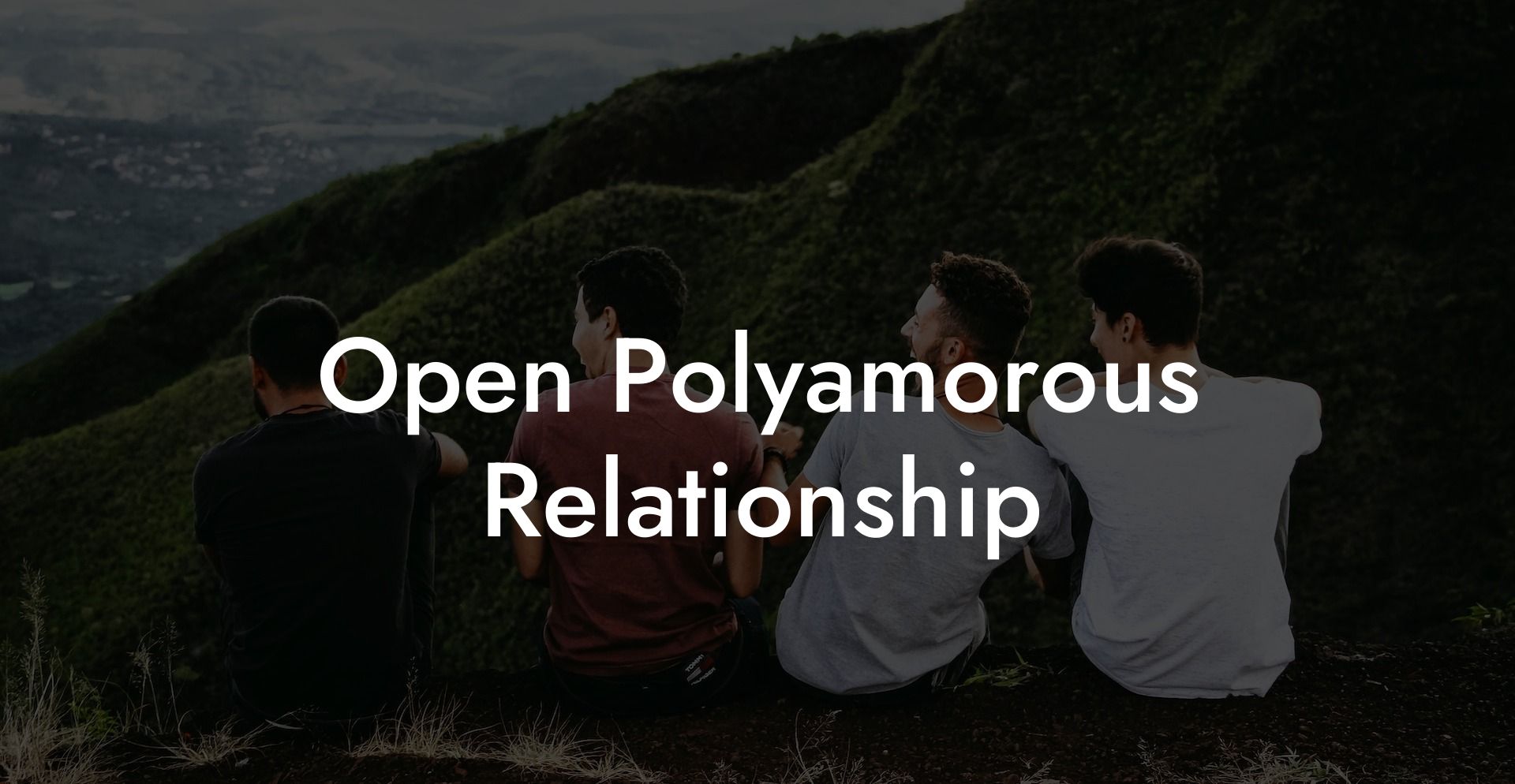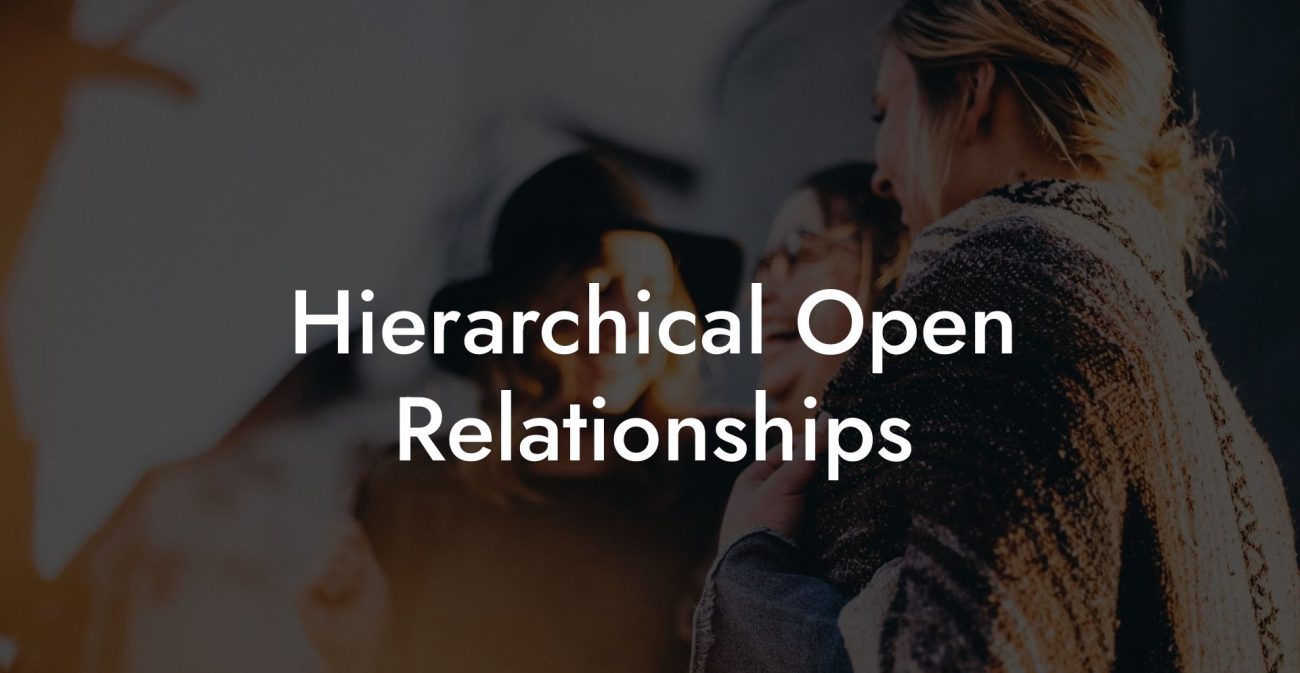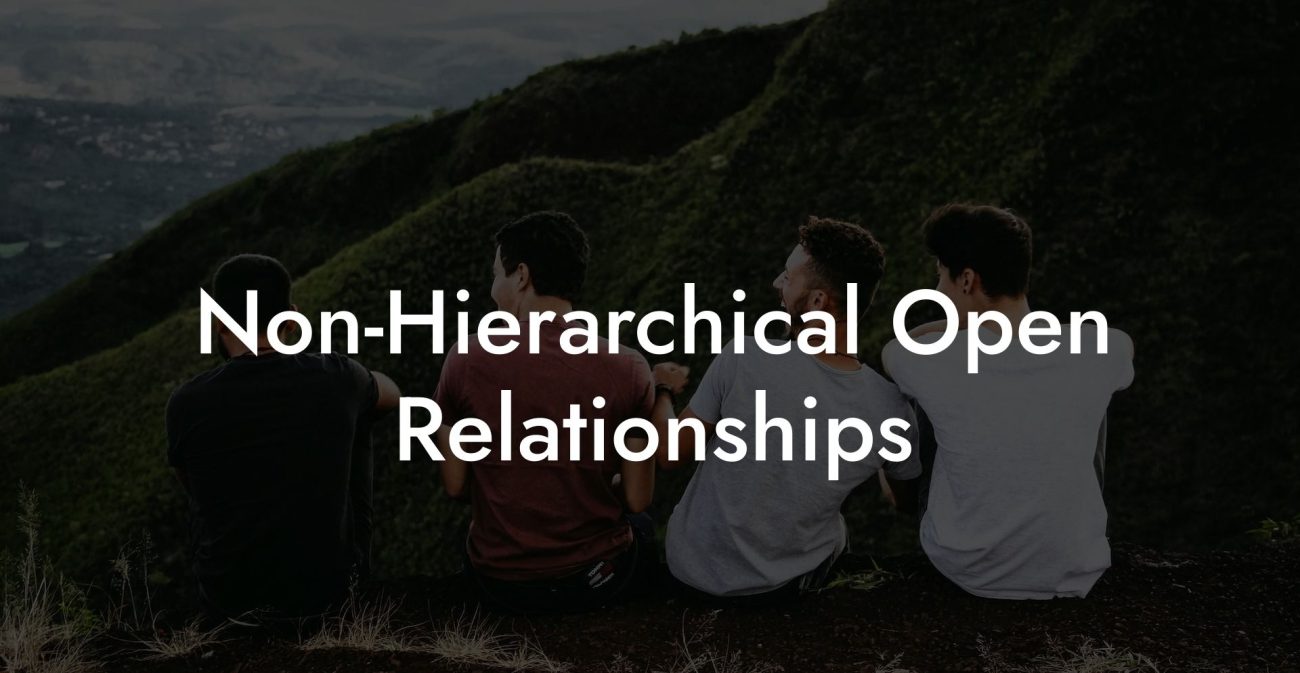Understanding Open Polyamorous Relationship

An open polyamorous relationship combines elements of polyamory, maintaining multiple romantic and/or sexual relationships, with the openness found in non-monogamous arrangements, allowing for a spectrum of connections that can be both emotionally deep and flexible. This guide will provide an in-depth look at what an open polyamorous relationship is, how it works, its core principles, benefits, challenges, and practical strategies to help you navigate this multifaceted lifestyle.
Quick Links to Useful Sections
- What Is an Open Polyamorous Relationship?
- Definition and Core Concepts
- Historical and Cultural Context
- The Evolution of Non-Monogamous Practices
- Core Principles of Open Polyamorous Relationships
- consent and Transparency
- Open Communication and Negotiation
- Flexibility and Autonomy
- Emotional Diversity and Depth
- Comparing Open Polyamory with Other Relationship Models
- Open Polyamory vs. Traditional Monogamy
- Open Polyamory vs. Closed Polyamory
- Open Polyamory vs. Open Relationships
- Benefits of an Open Polyamorous Relationship
- Emotional and Social Benefits
- Practical Benefits
- Challenges of an Open Polyamorous Relationship
- Emotional and Psychological Challenges
- Social and Cultural Challenges
- Practical Strategies for Success in an Open Polyamorous Relationship
- Enhance Communication and Transparency
- Establish Clear Boundaries and Agreements
- Prioritize Self-Care and Individual Growth
- Build a Supportive Community
- FAQ: Understanding Is There A Difference Between An Open Relationship And Polyamory?
What Is an Open Polyamorous Relationship?
Definition and Core Concepts
An open polyamorous relationship is a type of consensual non-monogamy where an individual or couple engages in multiple romantic and/or sexual relationships simultaneously while maintaining a level of openness that permits new connections and experiences. Unlike a strictly monogamous relationship, the open poly model is characterized by the acknowledgment that love, intimacy, and sexual fulfillment are not finite resources. In this framework, partners agree to form and maintain additional connections without compromising the integrity of their primary bonds.
The defining features of an open polyamorous relationship include:
- Consensual Non-monogamy: Every partner is fully aware of and consents to the existence of multiple relationships. There is no secrecy or deception.
- Open Communication: Regular, honest dialogue is essential to negotiate boundaries, share feelings, and address any issues that may arise as new connections form.
- Flexible Structure: The relationship can be organized in a variety of ways. Some may have a primary partnership with secondary relationships, while others may adopt a non-hierarchical model where all relationships are considered equally significant.
- Autonomy and Personal Growth: Each partner maintains their individuality and personal interests, even while engaging in multiple connections. This model encourages self-exploration and the pursuit of personal fulfillment alongside shared intimacy.
- Emotional Depth and Variety: Open polyamorous relationships often aim to provide a rich tapestry of emotional support by allowing different partners to fulfill different needs.
Historical and Cultural Context
The Evolution of Non-Monogamous Practices
Although the term "polyamory" is relatively modern, the practice of maintaining multiple relationships has existed throughout history. Many indigenous cultures and ancient societies embraced various forms of non-monogamy that allowed for multiple romantic bonds, communal living, and resource sharing. The modern open polyamorous movement builds on this historical legacy by emphasizing ethical non-monogamy, individual autonomy, and open communication.
In today’s progressive communities, open polyamory is celebrated as a way to redefine intimacy and relationship structures, challenging the notion that love must be exclusive to one partner. This cultural shift is driven by a desire for personal growth, freedom, and a deeper understanding of human connection.
Core Principles of Open Polyamorous Relationships
consent and Transparency
At the heart of open polyamory lies the principle of informed consent. Every person involved must be fully aware of the relationship dynamics and agree to participate. Transparency is key, and partners are encouraged to share their desires, fears, and expectations openly. This ongoing consent ensures that all relationships are built on mutual respect and understanding.
Open Communication and Negotiation
Open polyamorous relationships require continuous, multi-directional communication. Unlike monogamous relationships, where communication is focused on two people, open poly setups involve multiple parties. Regular check-ins, honest discussions, and the willingness to renegotiate boundaries as circumstances change are essential to sustaining healthy dynamics.
Flexibility and Autonomy
One of the defining aspects of an open polyamorous relationship is flexibility. Relationships may evolve, new partners may be introduced, and boundaries may shift over time. While there might be a central or primary bond, every partner is encouraged to maintain their individuality and pursue personal interests. This balance between connection and independence is a cornerstone of the open poly model.
Emotional Diversity and Depth
Open polyamory embraces the idea that different relationships can meet different emotional needs. Some connections may provide intellectual stimulation, while others offer deep emotional intimacy or physical satisfaction. This diversity allows individuals to experience a broader spectrum of love and support.
Comparing Open Polyamory with Other Relationship Models
Open Polyamory vs. Traditional Monogamy
In a traditional monogamous relationship, partners commit exclusively to each other, often with the expectation of lifelong fidelity. While this can foster a deep, focused emotional bond, it may also limit opportunities for exploring different facets of intimacy. Open polyamory, in contrast, allows for multiple relationships that can complement each other, providing varied sources of support and growth.
Open Polyamory vs. Closed Polyamory
Some polyamorous relationships are structured in a closed manner, where all partners are aware of each other and agree not to seek additional relationships beyond the established group. In open polyamory, however, there is more flexibility, and individuals may have external relationships in addition to their core connections. This openness can lead to a broader network of support, though it also requires more robust communication and boundary management.
Open Polyamory vs. Open Relationships
While open relationships typically involve a primary couple allowing for external sexual or romantic encounters, they do not always emphasize the formation of multiple deep, long-term bonds. Open polyamory, on the other hand, actively encourages the development of multiple emotionally significant relationships, even if one remains the central focus. This distinction means that open polyamory can be seen as a more expansive form of open non-monogamy, where the quality and depth of relationships are as important as the freedom to explore.
Benefits of an Open Polyamorous Relationship
Emotional and Social Benefits
- Diverse Emotional Support: With multiple partners, individuals can receive varied forms of support and care, which can enrich their emotional lives and foster personal growth.
- Increased Personal Freedom: The open poly model encourages individual autonomy and allows for the exploration of personal desires without sacrificing a central, committed bond.
- Enhanced Communication Skills: Managing multiple relationships requires and fosters advanced communication, negotiation, and conflict-resolution skills.
- Expanded Perspectives on Love: Engaging with multiple partners can broaden your understanding of intimacy and help you develop a more nuanced view of love and relationships.
Practical Benefits
- Flexibility in Lifestyle: Open polyamory offers a flexible relationship structure that can adapt to changing needs and circumstances, whether that means integrating new partners or shifting boundaries as personal growth occurs.
- Collaborative Problem-Solving: The diversity of perspectives within an open poly network can lead to innovative solutions to life’s challenges, whether related to finances, household management, or personal development.
Challenges of an Open Polyamorous Relationship
Emotional and Psychological Challenges
- Complex Emotional Dynamics: Balancing multiple intimate connections requires careful management of emotions, as issues such as jealousy, insecurity, and competition may arise.
- Time and Energy Constraints: Coordinating schedules and maintaining quality time with all partners can be demanding, requiring exceptional organizational and time management skills.
- Potential for Miscommunication: With more partners involved, the risk of misunderstandings increases, making transparent communication absolutely vital.
Social and Cultural Challenges
- Social Stigma: Despite growing acceptance, non-traditional relationship models like open polyamory may still face prejudice or misunderstanding from those who adhere to traditional norms.
- Lack of Legal Recognition: Like many forms of consensual non-monogamy, open polyamorous relationships are not formally recognized by legal systems, which can create challenges in areas such as inheritance, custody, and spousal benefits.
Practical Strategies for Success in an Open Polyamorous Relationship
Enhance Communication and Transparency
- Regular Check-Ins: Schedule frequent discussions with all partners to address feelings, update boundaries, and ensure that everyone’s needs are being met.
- Active Listening: Practice active listening by giving each partner your full attention and validating their feelings.
- Digital Tools: Use shared calendars, messaging apps, or group chats to coordinate schedules and maintain transparency.
Establish Clear Boundaries and Agreements
- Define Roles: Clearly articulate what each relationship means to you and how much time and energy you can devote to each.
- Negotiate Limits: Work with all partners to establish what is acceptable in terms of external interactions, ensuring that the primary bond is respected.
- Review Regularly: As relationships evolve, revisit and adjust boundaries to reflect new circumstances and personal growth.
Prioritize Self-Care and Individual Growth
- Personal Time: Dedicate time to activities that recharge you and foster your personal development, such as hobbies, exercise, or creative pursuits.
- Professional Support: Consider individual or group therapy to help manage complex emotions and improve communication skills.
- Mindfulness Practices: Incorporate mindfulness or meditation into your routine to maintain emotional balance and clarity.
Build a Supportive Community
- Join Online Forums: Engage with communities like r/polyamory to share experiences, seek advice, and receive validation from others who understand your lifestyle.
- Attend Workshops: Participate in workshops and webinars on ethical non-monogamy and relationship dynamics to gain insights and practical tips.
- Network Locally: Look for local meet-ups or support groups that focus on alternative relationship models to build a network of like-minded individuals.
FAQ: Understanding Is There A Difference Between An Open Relationship And Polyamory?
1. Are open relationships and polyamory the same?
No, they are not the same. Open relationships typically involve a primary couple allowing external sexual or casual romantic encounters, while polyamory involves forming multiple deep, emotionally significant relationships.
2. What is the main focus of an open polyamorous relationship?
In an open polyamorous relationship, the focus is on maintaining a central bond that remains open to additional, often emotionally significant, connections. It combines the openness to multiple relationships found in polyamory with the flexibility of open relationships.
3. How does communication differ in open polyamorous relationships?
Open polyamorous relationships require multi-directional communication among all partners to negotiate boundaries, share feelings, and manage emotions, whereas open relationships often involve focused communication between a primary couple regarding external encounters.
4. What are the legal recognitions for open polyamorous relationships?
Like other non-monogamous arrangements, open polyamorous relationships generally do not have formal legal recognition. The primary bond may benefit from legal recognition if it is structured as a traditional monogamous marriage, but additional relationships typically remain informal.
5. What emotional challenges might arise in an open polyamorous relationship?
Managing multiple intimate bonds can lead to challenges such as jealousy, feelings of neglect, and the difficulty of balancing emotional and practical commitments across several relationships.
6. Where can I find additional resources on open polyamory?
Additional resources include books such as "The Ethical Slut" by Dossie Easton & Janet Hardy and "More Than Two" by Franklin Veaux & Eve Rickert, as well as podcasts like "Multiamory" and "Polyamory Weekly." Online communities like r/polyamory are also excellent sources of support and information.
Resources and Community Support: Your Next Steps
- "The Ethical Slut" by Dossie Easton & Janet Hardy – A foundational text that explores ethical non-monogamy and provides deep insights into open and polyamorous relationships.
- "More Than Two" by Franklin Veaux & Eve Rickert – An in-depth guide offering practical advice on managing multiple relationships and navigating the complexities of consensual non-monogamy.
- Podcasts: Listen to "Multiamory" and "Polyamory Weekly" for engaging discussions and personal stories about diverse relationship models.
- Online Communities: Join forums such as r/polyamory to exchange ideas and receive support.
- Workshops and Webinars: Attend events on relationship psychology and ethical non-monogamy to expand your knowledge and connect with like-minded individuals.
By exploring these resources and applying the strategies outlined in this guide, you can develop a clear, informed understanding of open polyamorous relationships and how they fit into the broader spectrum of consensual non-monogamy. Embrace continuous learning, open dialogue, and self-reflection as you navigate the diverse landscape of modern intimacy.
Lost & confused by all of the terms, types and seemingly made up 3 letter acronyms?? We've got you. Check out our Ethnical Non-Monogamy Dictionary >>
Useful Interruption: Not sure which relationship vibe fits you best? Take our Relationship Test, it’ll give you the real insight into your natural relationship style. Then, dive into our binge-worthy guides (from the tried-and-true to the “wait, that’s a thing?”) and find the perfect relationship type for your life:
- Monogamy
- Open Relationships
- Ethical Non-Monogamy
- Solo Polyamory
- Non-Hierarchical Polyamory
- Hierarchical Polyamory
- Relationship Anarchy
- Swinging
Now back to the main article but yeah take the test...












